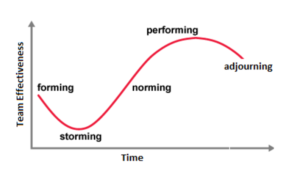The Importance of Psychological Safety in Team Development
Contents |
Abstract
The concept of psychological safety was introduced over twenty years ago by Edmonson [1]. It entails the creation of a safe space where the individual members of a team can express their ideas and concerns in the workplace, knowing that they will be listened to and not judged. When Team Psychological Safety (TPS) is achieved, a sense of interpersonal trust is developed among the teammates, which leads to better outcomes. The importance of TPS lies in the benefits that it brings to the overall team performance. Reducing the fear of taking risks, increases the innovation potential of a team [2]. Likewise, trust and openness lead to more active and effective communication. Once the main benefits are identified, two main issues arise i) how is TPS achieved and; ii) when does it emerge?
The first issue is explored by conducting a literature review with a view to understanding the nature of TPS, as well as the qualitative and quantitative assessments of the same. The latter is addressed by exploring Tuckman’s Model of Team Development. This model is widely recognized and referenced, where five stages are identified are: forming, storming, norming, performing and adjourning. The present work analyzes the aforementioned stages of team development from a psychological safety point of view [3]. The case, in which a newly created team is formed, will address where and how TPS is sparked, as well as its role and evolution through the stages of team development. Lastly, new strategies will be proposed for leaders to promote the development of TPS in the early stages, creating a supportive work environment.
Introduction
Psychological safety in teams
Benefits
Measuring
Improving psychological safety
Tuckman's Model of Team Development and Psychological Safety
Overview of Tuckman's Model
In his team development model, professor Bruce Tuckman distinguishes between interpersonal relations among group members (group structure) and task activity in the different stages of team development. The core identified stages are forming, storming, norming and performing. The following characteristics were identified in natural group settings, where tasks were rather impersonal. This is usually the case with technical engineering tasks. The characteristics of each stage will be described taking an engineering team as an example.
- Forming
In this phase, the main roles are defined. The leadership role is given by the position, in this case, the project manager holds it. At this time, both the project manager and other team members have space for testing and understanding the team's boundaries. There is also room for exploring and scoping the task to determine how the team can approach it.
- Storming
This stage is characterized by the emotional response of the team members to conflict. Leadership problems arise, thus animosity among the engineers emerges and hierarchies are re-established. The storming phase has a lower relevance on intellectual and impersonal tasks, as it tends not to affect at a personal level.
- Norming
The team accepts each other and understands the differences between them, a common language between the team is found and interpersonal relationships grow. In the task activity domain, the team members openly express their opinion and evaluation of the developed work.
- Performing
In this phase, the team is characterized by its solid establishment. They have the ability to adopt their roles and perform the expected tasks as a competent team. Engineers are confident in performing their tasks while still relying on each other.
- Adjourning
missing info - still reviewing literature
The following figure relates team effectiveness and time. It can be seen that the storming phase takes place at a rather early time and represents the lowest effectiveness of the team performance. 
Analysis of the five stages of team development from a TPS point of view
The role of psychological safety in each stage of team development
Discussion and limitations
Conclusion
Cited works
[1] Edmondson, A. (1999). Psychological Safety and Learning Behavior in Work Teams. Administrative Science Quarterly, 44(2), 350–383. https://doi.org/10.2307/2666999 [2] Newman, Alexander, Ross Donohue, and Nathan Eva. "Psychological safety: A systematic review of the literature." Human resource management review 27.3 (2017): 521-535. [3] Tuckman, Bruce W., and Mary Ann C. Jensen. "Stages of small-group development revisited." Group & organization studies 2.4 (1977): 419-427.